Experiments in Human Nature / Monica O'Rourke
 Two Backed Books / January 2008
Two Backed Books / January 2008
Reviewed by: Jeff Burk
If there is any justice in the publishing industry, Monica O’Rourke’s latest collection of short stories, Experiments in Human Nature, will propel her to the very top of the field.
Primarily known to readers for the most hardcore horror, her stories explore the darkest elements of humanity and are written with strong prose and fierce underlying intelligence.
As the title suggests, most of the stories in Experiments in Human Nature are concerned with horrors that exist (or can exist) in the real world. Child abuse, rape, and cannibalism are common enough in her stories that they could be considered themes — although vampires, witches, and ghosts also make plenty of appearances. This diversity keeps the reader constantly off guard, never knowing what to expect from the next story.
What immediately sets O'Rourke's stories apart from other horror writers is her choice of subject matter. She writes from a decidedly female perspective, with tales focusing on fears associated with children, body image, and the loss of identity associated with relationships. She addresses many topics ripe for horror that her male contemporaries are likely to neglect. This lends the stories in Experiments a strong feeling of originality and the reader is not left with the sense that they've been there, done that.
In a genre commonly accused – and frequently guilty – of exploiting violence and sexuality, Experiments in Human Nature stands as a shining example of how these topics can – and perhaps should – be handled. O'Rourke holds up a mirror and shows the world its sometimes painful reflection. This collection is an essential addition to the discerning horror fan's shelf and one that’s certain to win O’Rourke legions of new fans.
Purchase Experiments in Human Nature by Monica O’Rourke.
Sweetheart / Chelsea Cain
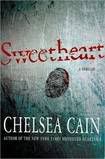 St. Martin’s Minotaur / September 2008
St. Martin’s Minotaur / September 2008
Reviewed by: Martel Sardina
Chelsea Cain’s Archie Sheridan series can be summed up with one thought: The Silence of the Lambs with a female Hannibal Lector. In her debut novel, Heartsick, Cain used this gender reversal to pump new life into a sub-genre that had gone stale. And while her follow-up, Sweetheart, is a well-written, fast-paced thrill ride, there is something lacking in Cain’s execution that may leave readers to wonder where Cain can go from here. Misgivings about future installments aside, Cain still delivers on the promise of Heartsick by providing fans a great read.
After bringing Gretchen Lowell (aka the Beauty Killer) to justice for her crimes, Detective Archie Sheridan can’t seem to rest knowing that there are still unidentified victims out there with families waiting for closure. Gretchen continues to manipulate him from her jail cell, avoiding a death sentence by agreeing to reveal the locations of her other victims, albeit with a catch — she will only talk to Archie. For Archie, having to maintain contact with Gretchen – despite being her only surviving victim – has taken its toll on him. Archie is trying to repair his relationship with his ex-wife and children and realizes the only way to do that is to give up his weekly visitations with Gretchen. And even though he makes it two months without a visit, he feels like he’s just going through the motions. Somehow, despite everything, his business with Gretchen is more important. Archie soon wonders if he made the wrong choice.
Archie is called to Portland’s Forest Park after the body of a young woman is discovered. The last time a body was found in this area, it turned out to be the start of the Beauty Killer Case. The two cases can’t possibly be related since Gretchen Lowell is tucked safely behind bars, so Archie turns to his friend Susan Ward – a newspaper reporter and another Heartsick leftover – for help in determining the dead woman’s identity. Once they learn the identity of their Jane Doe, Archie and Susan realize they are in the midst of an even bigger story with far-reaching political ramifications. Distractions ensue for Archie, however, once he learns that Gretchen Lowell has escaped from prison.
It’s no surprise to the reader that Gretchen’s escape secretly comes as a relief to Archie, who now has valid reason to put an end to his ex-wife’s moratorium on the serial killing beauty. Archie knows that he is the only one capable of catching her — and, this time, he is willing to resume the pursuit no matter what the personal cost.
The problem with series mysteries is that with each book, the author’s challenge is to offer the reader something new. Sweetheart offers some new insights into the various characters, revealing hidden motivations. But this time around, the story line – however tightly plotted and fast-paced a read – feels a bit too formulaic, leaving this reader to think that she might have enjoyed it more had she not already read Heartsick.
Open-ended elements in Sweetheart may be clues as to what to expect from Cain’s next offering in the Archie Sheridan series. Here’s hoping those clues are just red herrings.
Purchase Chelsea Cain’s Sweetheart.
Mother Puncher / Gina Ranalli
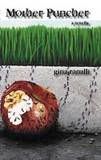 Afterbirth Books / June 2008
Afterbirth Books / June 2008
Reviewed by: Jeff Burk
You might not know who Gina Ranalli is, but you will soon. As the author of several novellas and numerous short stories, Ranalli has already developed a modest cult following. Closely associated with the bizarro community, her latest novella from Afterbirth books, Mother Puncher, has gotten the wider horror scene buzzing — and for good reason. She has written a dark and twisted social satire that stands high above the genre competition.
The world is suffering a population problem; there are too many people and not enough resources. To discourage reproduction, the government has resorted to creative problem solving. That’s where Ed Means comes in. He is a Mother Puncher. It is his job to give mothers (and fathers — when they’re around) a good punch right after their child's birth so they remember not to spawn again. To tell any more would spoil the story's many twists and turns.
Far from your standard horror tale, the closest one gets to a monster here is government policy. The absence of traditional horror elements notwithstanding, the darkness of the storyline will make this slim volume feel right a home in any collection of weird fiction. Ranalli paints a world on the brink of collapse, one in which the most absurd solutions seem rational.
The horror genre has always easily lent itself to social and political commentary. Through it, talented writers can manipulate and explore the darker side of human nature. Following in the footsteps of H. G. Wells and Bentley Little, Ranalli has crafted a tale that comments on gender, the birth industry, and an individual's right to determine his or her own destiny. Admittedly, these are heavy topics to be dealt with in escapist fiction, and there is an ever-present danger of a writer losing sense of their story for the sake of preaching to an audience. Fortunately, Ranalli avoids this pitfall and never loses sight of the story in the bigger issues with she is dealing. Watch for her profile to continue to rise.
Purchase Mother Puncher by Gina Ranalli.
The Book of Lists: Horror / Edited by Amy Wallace, Del Howison, & Scott Bradley
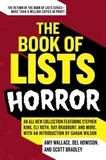 Harper / September 2008
Harper / September 2008
Reviewed by: Vince A. Liaguno
Every once in awhile, horror shows us its fun side. In The Book of Lists: Horror, a wonderful new compendium that will leave genre enthusiasts glassy eyed and drooling into the wee hours of the night, editors Wallace, Howison, and Bradley ably pull together the vast elements of this classic genre. Straddling a fine line between trivia and contributor opinion, the collection offers up a plethora of lists – spanning movies, television, literature, music, even comic books and video games – compiled by genre royalty (Stephen King, Ray Bradbury, and Robert Block), respected genre editors and critics (Fangoria’s Anthony Timpone, Tim Lucas, and Leisure’s Don D’Auria), and the genre’s next generation (Eli Roth, Hatchet director Adam Green, and Neil Marshall).
No surprise that horror’s medium du jour – film – kicks off the collection and receives the largest page count. Movie fanatics will be delighted by 217 overstuffed pages that include horror icons and genre friends (Joey Ramone, Cerina Vincent) listing their favorite scary movies, academic discussions and thoughtful dissections (Professor Leo Braudy’s "Eleven Favorite Moments of Horror vs. Terror in Film”, Alan Beatt’s "Five Common Tactical Errors in Horror Films”), and interactive fun (“Match the Horror Film with Its Tagline”, Sarah Langan’s "Top Ten Stupidest Horror Movie Decisions Quiz”). There’s a nice balance between the serious and the silly with cerebral fare like Richard Stanley’s critical examination of Italian horror movies and F.X. Feeney’s engaging look at horror films featuring children being balanced by decidedly lighthearted fare like Edward Lee’s “Ten Best Horror Movies with Gratuitous Nudity”, Green’s suggestion of ten actresses who should have gotten naked onscreen but didn’t (Kathy Bates or Dakota Fanning(!) anyone?), and Vince Churchill’s is-it-or-isn’t-it politically correct look at racial survival rates in horror movies tellingly titled “Top Ten List of Films in Which, Wow, the Black Guy Lived!”. Standout here is Timpone’s look back at “Ten Films I Wish I Never Put on the Cover of Fangoria,” a playful lament that includes King’s Maximum Overdrive, Gus Van Sant’s Psycho remake, and the Jamie Lee Curtis sci-fi/horror hybrid Virus (I forgive you for including the latter, Tony.) Notable mentions include: Victor Salva’s “Ten Things We Have Learned from Horror Movies” (Always assume the calls are coming from inside the house – wherever you are.), “The Original Titles of Fifteen Horror Films”, and Tim Sullivan’s "Thirteen Favorite ‘Splatstick’ Moments” (Hey, anyone smart enough to give Motel Hell its due props gets an honorable mention!).
Dark genre fiction receives some respectable coverage in the book and bibliophiles will delight at appearances by Bentley Little, Jack Ketchum, Ramsey Campbell, Sarah Langan, Edward Lee, Gary Braunbeck, Sarah Pinborough, Poppy Z. Brite, and Michael Marshall Smith. Topics range from the factual (“The Fifty-Six Bestselling Horror Books Since 1900” and “The Original Titles of Twenty Horror Novels”) to pop culture trivia (“Revealed! The Pseudonyms of Seventeen Horror Writers”) to genuinely useful academic reference guides (Thomas Ligotti’s “Ten Classics of Horror Poetry”). The standout of this section is UK dark scribe Pinborough who offers up a brilliant cautionary travelogue of sorts, evaluating famous fictional settings as possible vacation destinations. With tongue planted firmly in cheek, she weighs the pros and cons of staying at the Overlook Hotel, the Bates Motel, and Hill House, in the idyllic towns of Castle Rock and Derry, and even in big cities like London and Paris. Other highlights include Little’s “Ten Horror One-Hit Wonders That Everyone Should Read,” Wallace’s and Bradley’s list of “Nine Horror Writers Who Have Written Children’s or Young Adult Books,” and D’Auria’s “Ten Books That Changed the Horror Genre.”
Music and miscellany split the last 100 pages of The Book of Lists: Horror, with fascinating looks at a horror hodgepodge that includes horror movie soundtracks, opera, comic books, board and video games, and even mixology that will gratify audiophiles, gamers, and even those who enjoy the occasional spirit. Noteworthy contributions in these last three chapters include: David T. Wilbanks’ “Ten Favorite Dark Works of Classical Music”; frequent Argento actress Coralina Cataldi-Tassoni’s “Ten Favorite Tragically Romantic Heroine Deaths in Opera”; S.P. Somtow’s “Top Ten Gruesome Operatic Deaths”; novelist Scott Heim’s “Ten Creepiest Made-For-TV Movies (or TV Series Episodes)”; Mitch Brian’s “Nine Amazing Horror Board Games”; Armand Constantine’s “Five Scariest Video Games”; Bradley’s and John Skipp’s compilation of “Ten Horror Cocktails (And How to Make Them)”; and twelve-year old Zoe Brian’s endearing list of “Top Ten Creepy Movies for a Seventh-Grade Slumber Party”. Accolades here are reserved for Michael A. Arnzen, whose “Top Five Horror Colleges” is by far the most ingenious contribution in the book and a useful guide to where some of the most important horror-related literary archives (Lovecraft, King) are located and where students of the genre can find a tailor-made experience in horror higher learning.
The Book of Lists: Horror is a fun-filled book that’s jam-packed with enough trivia, insight, and commentary to enthrall, engross, and engage even the most information-overloaded genre buff. It’s the trade paperback version of a coffee-table book without the pictures that you’re likely to revisit time and time again. Editors Wallace, Howison, and Bradley earn deserved props for assembling and somehow organizing the blissful overabundance of eclectic information they present. An absolute “must read” for horror aficionados of all tastes, shapes, and sizes.
Purchase The Book of Lists: Horror, edited by Amy Wallace, Del Howison, and Scott Bradley.
Trigger City / Sean Chercover
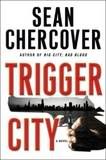 William Morrow / October 2008
William Morrow / October 2008
Reviewed by: Martel Sardina
One of the challenges all novelists face is making sure that their next book is as good – if not better – than their last. When the author’s debut novel goes on to be nominated for several major awards – as Sean Chercover’s Big City, Bad Blood did – the author is under even more pressure to exceed reader expectations with his sophomore effort. As good as Chercover’s debut was, this reviewer is happy to report that Trigger City is better.
Chercover’s hero, Ray Dudgeon, is back, and though he survived his battle with some of The Outfit’s toughest criminals, that doesn’t mean he’s left his demons behind. Ray is still reeling from his breakup with Jill, and he’s second-guessing his skills as a private investigator after a case he works in the interim leaves an innocent woman dead. Not that it matters — his skills haven’t been put to use much in recent months. After most of his good gigs dry up, Ray has no choice but to go back to process serving and divorce cases until his truce with The Outfit comes through.
The loss of income has also prevented Ray from getting a much-needed shoulder surgery. While Ray waits for things to turn around financially, he manages his pain with illegally obtained Percocets and drinks a bit more than he should. Ray can run but he can’t hide from his past. Everywhere he goes, everyone he knows reminds him of what he’s lost so far. That’s what makes Chicago Ray’s “Trigger City.”
When a grieving father offers to hire Ray to investigate his daughter’s death, Ray knows he shouldn’t take the case. Joan Richmond was murdered. Her killer, Steven Zhang, left a signed confession at the scene before returning home and killing himself. The facts of Joan’s murder are black and white. Chicago PD considers the case closed. But Joan’s father, a retired Army Intelligence Colonel, doesn’t care what the facts say. He wants the truth. And Ray knows that when the client’s goal is to find the truth, he should run away as fast as he can. The truth hurts. How much more pain is Ray prepared to take?
As Ray searches for answers, he is pushed both professionally and personally to find out what kind of man he really is. The pursuit of truth leads Ray into the dark underbelly of a world where military contractors, intelligence operatives, and government leaders play by a different set of rules. Rules that we know exist, but pretend they don’t to save ourselves from living in constant fear. Ray must navigate these shark-infested waters carefully until he can figure out how not to become collateral damage in a war he never meant to become involved in.
Will Ray turn a blind eye to glaring inconsistencies in order to wrap up the case quickly and send Colonel Richmond on his way? Will he allow ex-girlfriend Jill to get away for good without putting up a fight? Is he still able to discern between good and evil? And as he makes those choices, can he live with the man that he has become as a result of the experiences he’s endured?
While Chercover’s debut novel was enjoyable on the whole, it was his voice that made the story shine more than the events that unfolded. Many crime novels set in Chicago have some aspect of Mafia involvement. The surprise was not that Chercover chose to battle The Outfit, but in getting to know his character intimately along the way. In Trigger City, while the voice is all Dudgeon, this time Chercover’s tightly woven plot is the gem. Readers will turn page after page while they curse him for writing such a spine-tingling noir adventure.
Purchase Trigger City by Sean Chercover.
The Damned / William Ollie
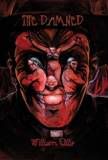 Bloodletting Press (Morning Star) / Fall 2008
Bloodletting Press (Morning Star) / Fall 2008
Reviewed by: Michele Lee
There's a lot of story in The Damned by William Ollie. It starts with Scott, who has just been fired from his job for an essentially trivial reason and is driving home to his wife. Unfortunately, on the way home, he causes an accident that ends with him becoming the victim of a road rage shooting.
Taking a bullet to the head is the least of Scott's worries as his own brush with death coincides with a strange event that just might be the Biblical end of the world. Scott wakes up, seven weeks later, in a hospital filled with corpses, in a world gone literally to hell. Scott has to find a way to survive, while having to come to terms with the idea that everyone he meets is someone left behind, unworthy of God's grace.
The Damned doesn't try to comment on religious issues. Other than the basic premise, God doesn't come up much. Perhaps that's a reflection of the book's world, which is the epitome of a godless world.
While filled with brutal atrocities, The Damned isn't interested in building a world of gross-outs that increase in intensity. After the initial shock (to both the reader and to Scott) of the newfound horror of the world, the book moves on, maintaining a respectable level of violence, action, and blood, but turning to an interesting and conflicted story.
The most intriguing aspect of The Damned is how Ollie establishes at the beginning that every character the reader meets has either done something evil, or is truly evil, including the "hero" Scott. We know his evil from the outset, and through the story we learn (sometimes too late) of others' evil. Ollie does a fantastic job of making the reader almost forget the wickedness of his characters. Even the most evil of them all, the nasty gang leader and area terrorist Dub, has his moments of being cast as a would-be hero.
This conflict, created largely in the reader's mind as we wonder who, if anyone, we should cheer for, sets this book apart from others on the shelf.
The pacing, while not breakneck, is steady. The plot, despite its focus on mere survival at times, ties up nicely and prepares to jump forward into interesting new areas, leaving the end both satisfying and open to further volumes. The Damned is a solid, interesting debut novel.
Pre-order The Damned by William Ollie.
Covenant / John Everson
 Leisure / August 2008
Leisure / August 2008
Reviewed by: Martel Sardina
Joe Kieran left Chicago to escape the hustle and bustle of reporting the news and other scandals that occur on a daily basis in one of the country’s most corrupt cities. When he settled in the northeastern coastal town of Terral, he found the lack of news to be a pleasant relief, for a time. However, after one of the locals, James Canady, commits suicide by jumping from Terrel’s Peak, Kieran is baffled by his editor’s response when he asks to cover the story.
“Sit this one out, Joe.”
Joe can’t understand why Canady’s suicide isn’t worthy of coverage. It’s the most newsworthy thing that’s happened since Joe came to town. The more Joe thinks about it, the more he needs to know what happened to drive a young man with seemingly everything to live for to end his life on the jagged rocks below the cliff. When Joe discovers that Canady isn’t the first jumper, but rather just the cliff’s latest victim, he can’t ignore the possibility that somehow the deaths could be related. Is there a serial killer loose in Terrel? Joe must find out who or what is causing these crimes.
But uncovering information about the cliff jumpers proves difficult. No one in town wants to talk about what goes on up at Terrel’s Peak. Several of the townsfolk, including the members of the police force tell Joe that he’d be better off to just leave things be. Joe gets a tip from his friend, George, the janitor at the Terrel Times. George tells Joe that Angelica, the town’s resident fortuneteller, might be able to shed some light on the subject. Joe is skeptical but goes to see her anyway. Like others in town, she questions Joe’s motivations and leaves him with more questions than answers.
Further investigation leads Joe to Cindy Marshfield, the girlfriend of the now deceased James Canady. Cindy shares her insights on growing up in Terrel and James’ state of mind prior to his death. While Cindy was able to leave Terrel to attend college, James couldn’t follow her. Something wouldn’t allow him to go. Cindy hypothesized that his mother was to blame, but now has doubts. A greater force could have been responsible.
James Canady’s mother, Rhonda was one of a group of friends who had each lost a child to Terrel’s Peak. This revelation sends Joe back to Angelica, who was also one Rhonda’s friends and seems to be the only one to have escaped the curse. That is until Joe learns that Angelica had a child too, but thought she had saved her daughter by giving her up for adoption. When Angelica goes missing, Joe calls in some favors from friends back in Chicago to find Angelica’s long-lost daughter. Both of their lives are in danger and Joe is running short on time.
Everson allows the storylines to unfurl, carefully layering each of the individual character’s arcs as he crosses genres ending up with a nice blend of mystery and horror. Once Joe Kieran uncovers the source of evil that lurks in Terrel’s Peak, Everson takes the reader on a thrill ride, leaving the reader to wonder if it is even possible for Kieran to contain it.
Covenant is Everson’s first novel. Delirium Books released it in limited edition hardcover in 2004. It went on to win the Bram Stoker Award for Best First Novel. The award led to Leisure’s acquisition of Covenant and its sequel, Sacrifice, which will also be released in mass-market paperback in 2009.
Purchase Covenant by John Everson.




